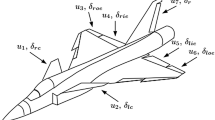Abstract
This paper presents an adaptive control allocation technique for over-actuated systems. The online actuator selection algorithm is used to select the best group of actuators. Also, a multi-objective cost function is utilized for the allocation unit. The virtual and actual control signals in the control allocation methodologies are linked by the effectiveness matrix. In many practical systems, the elements of the effectiveness matrix may vary due to changing operating conditions, nonlinearities, ageing, disturbances and faults. Hence, an online algorithm for estimation of the entries of the effectiveness matrix is presented in this paper. Estimation of the effectiveness matrix will be used for the proposed adaptive actuator selection strategy, employing the Actuator Effectiveness Index (AEI). The AEI is calculated for all the actuators, and the best group of actuators will be subsequently selected. Finally, simulation results are used to show the effectiveness of the proposed methodology.









Similar content being viewed by others
References
Johansen TA, Fossen TI (2013) Control allocation—a survey. Automatica 49(5):1087–1103. https://doi.org/10.1016/j.automatica.2013.01.035
Gao Z, Antsaklis PJ (1991) Stability of the pseudo-inverse method for reconfigurable control systems. Int J Control 53(3):717–729. https://doi.org/10.1080/00207179108953643
Jin J (2005) Modified pseudoinverse redistribution methods for redundant controls allocation. J Guid Control Dyn 28(5):1076–1079
Vayalali P, McKay M, Gandhi F (2020) Redistributed pseudoinverse control allocation for actuator failure on a compound helicopter. In: Conference: the vertical flight society’s 76th annual forum and technology Display
Buffington JM, Enns DF (1996) Lyapunov stability analysis of daisy chain control allocation. J Guid Control Dyn 19(6):1226–1230. https://doi.org/10.2514/3.21776
Tohidi SS, Khaki Sedigh A, Buzorgnia D (2016) Fault tolerant control design using adaptive control allocation based on the pseudo inverse along the null space. Int J Robust Nonlinear Control 26(16):3541–3557
Durham WC (1993) Constrained control allocation. J Guid Control Dyn 16(4):717–725
Naderi M, Johansen TA, Khaki SA (2019) A fault tolerant control scheme using the feasible constrained control allocation strategy. Int J Autom Comput 16(5):628–643
Doman DB, Sparks AG (2002) Concepts for constrained control allocation of mixed quadratic and linear effectors. In: Proceedings of the 2002 American control conference (IEEE Cat. No. CH37301), vol. 5. IEEE, pp 3729–3734. https://doi.org/10.1109/ACC.2002.1024507
Frost S, Bodson M, Acosta D (2009) Sensitivity analysis of linear programming and quadratic programming algorithms for control allocation. In: AIAA Infotech@ aerospace conference and AIAA unmanned... unlimited conference, p 1936. https://doi.org/10.2514/6.2009-1936
Härkegård O (2004) Dynamic control allocation using constrained quadratic programming. J Guid Control Dyn 27(6):1028–1034. https://doi.org/10.2514/1.11607
Kolaric P, Lopez VG, Lewis FL (2020) Optimal dynamic control allocation with guaranteed constraints and online reinforcement learning. Automatica 122:109265
Chen L, Edwards C, Alwi H, Sato M (2020) Flight evaluation of a sliding mode online control allocation scheme for fault tolerant control. Automatica 114:108829
Grauer JA, Pei J (2022) Minimum-variance control allocation considering parametric model uncertainty. In: AIAA SCITECH 2022 Forum, p 0749
Casavola A, Garone E (2010) Fault-tolerant adaptive control allocation schemes for overactuated systems. Int J Robust Nonlinear Control 20(17):1958–1980. https://doi.org/10.1002/rnc.1561
Doman DB, Ngo AD (2002) Dynamic inversion-based adaptive/reconfigurable control of the X-33 on ascent. J Guid Control Dyn 25(2):275–284. https://doi.org/10.2514/2.4879
Ahmad H (2009) Fault adaptation by reconfiguring flight controls using control allocation. Ph.d dissertation, Limerick University
Kim J, Yang I, Lee D (2011) Accommodation of actuator faults using control allocation with modified daisy chaining. In: 2011 11th International conference on control, automation and systems. IEEE, pp 717–720
Naderi M, Khaki SA (2020) Actuator selection for over-actuated systems using the actuator effectiveness index. Int J Dyn Control 8(3):991–998. https://doi.org/10.1007/s40435-020-00610-5
Wang Y, Gao J, Li K, Chen H (2020) Integrated design of control allocation and triple-step control for over-actuated electric ground vehicles with actuator faults. J Franklin Inst 357(6):3150–3167
Da Ronch A, Ghoreyshi M, Vallespin D, Badcock K, Mengmeng Z, Opplestrup J, Rizzi A (2011) A framework for constrained control allocation using CFD-based tabular data. In: 49th AIAA aerospace sciences meeting including the new horizons, forum and aerospace exposition, p 925. https://doi.org/10.2514/6.2011-925
Ioannou P, Fidan B (2006) Adaptive control tutorial. Soc Ind Appl Math
Ioannou PA, Sun J (1996) Robust adaptive control, vol 1. PTR Prentice-Hall, Upper Saddle River
Antunes CH, Liu GP, Yang JB, Whidborne JF (2006) Multiobjective optimisation and control. In: Series: engineering systems modelling and control, research studies press (2003) ISBN 0 86380 264 8
Dadhich S, Birk W (2014) Analysis and control of an extended quadruple tank process. In: 2014 European control conference (ECC). IEEE, pp 838–843. https://doi.org/10.1109/ECC.2014.6862290
Author information
Authors and Affiliations
Corresponding author
Rights and permissions
Springer Nature or its licensor holds exclusive rights to this article under a publishing agreement with the author(s) or other rightsholder(s); author self-archiving of the accepted manuscript version of this article is solely governed by the terms of such publishing agreement and applicable law.
About this article
Cite this article
Jafari, S.R., Khaki-Sedigh, A. & Birk, W. Adaptive multi-objective control allocation with online actuator selection for over-actuated systems. Int. J. Dynam. Control 11, 1220–1229 (2023). https://doi.org/10.1007/s40435-022-01054-9
Received:
Revised:
Accepted:
Published:
Issue Date:
DOI: https://doi.org/10.1007/s40435-022-01054-9




